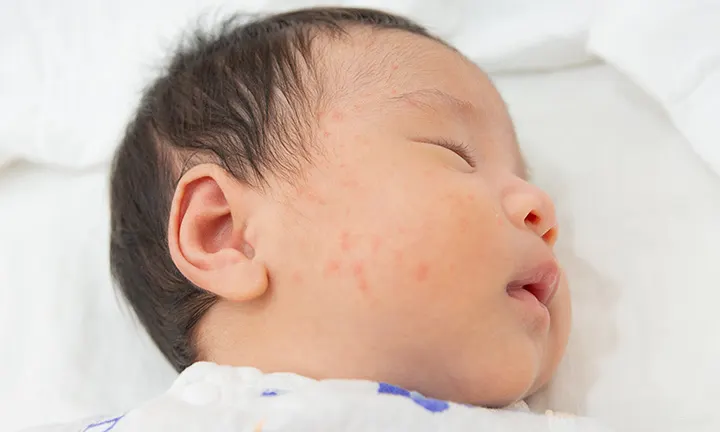Baby Hives: All About the Symptoms, Causes, and Treatments
Babies’ skin is generally sensitive, and infants may develop some issues from time to time, including little red bumps, rashes, or hives. When you see hives on your baby, you may wonder what (if anything) you should do to treat them and when to call your child’s healthcare provider. Read on to learn about the symptoms, causes, and treatment of hives in babies and when the provider can help.
What Are Baby Hives?
Hives—known in the medical world as urticaria—are red, swollen bumps that appear on the skin. They can affect anyone, including infants, toddlers, older kids, and adults. In fact, with sensitive skin, your little one will most likely experience some type of rash, hives, or skin irritation in their first few months and years of life.
Luckily, hives on babies tend to resolve themselves and are usually not a cause for concern. Below you’ll learn how hives appear and what types of hives might affect your baby.
Hives can appear anywhere on the body, including on your baby or toddler’s face, legs, arms, back, bottom, and belly. They may look like tiny bumps, widespread blotches, or large, elevated welts.
Hives appear when cells in the body’s bloodstream release histamine. This chemical causes the tiny blood vessels under the skin to leak fluid, which then pools, forming spots, bumps, welts, or blotching.
Hives can be acute or chronic:
If your baby has acute hives, the welts will disappear within hours or weeks. They may come and go but won’t last more than six weeks in total.
Chronic hives are when your newborn, baby, or toddler experiences hives that last longer than six weeks.
What Causes Hives in Babies?
Whether your baby is 1 month or 1 year old, they may occasionally experience hives on their body and/or face. Identifying what triggers acute hives can be tricky; in almost half of these cases, the cause cannot be determined. Many times, though, babies break out in hives when they have an infection or an allergic reaction, or when they touch something that irritates their skin.
Viral and Bacterial Infections
One likely cause of hives in children is a viral infection. If your little one comes down with a virus, hives may appear all over their body. You may notice other symptoms of a virus, too, including fever, cough, or diarrhea.
How long do these viral hives last in children? Most often, hives that erupt because of a virus will be acute, lasting just a few days.
Hives can also accompany certain bacterial infections, including strep throat and urinary tract infections (UTIs).
Allergies
You may also notice hives on your baby’s body or face if your little one has an allergy—a condition in which the immune system reacts to a substance as though it’s harmful. Babies can experience hives when having an allergic reaction to something specific, such as
food (peanuts, milk, shellfish, etc.)
pollen
pet dander
insect bites and stings
certain medications, such as antibiotics or ibuprofen.
When resulting from an allergy, acute hives will usually appear on your baby within minutes. Try to remember what your little one ate or what they were doing before the hives appeared so that you can pinpoint the trigger and share it with your baby’s healthcare provider.
Although most mild cases will go away on their own, if your baby experiences hives due to food allergies or has chronic hives, it’s important to contact their healthcare provider to determine the cause and receive the correct course of treatment. And when your baby is showing signs of a more serious allergic reaction (trouble breathing, fainting, swelling, etc.), you’ll want to take your baby to the emergency room (more on that below).
External Irritants and Other Potential Causes
Hives on babies can be caused by other things as well, such as exposure to hot or cold temperatures or direct sunlight. When hives appear in just one place rather than all over the body, a common cause of these welts on babies is basic skin irritation stemming from something that’s touching your baby. Among the possible triggers are
pressure on the skin (from sitting or lying in one position, for example)
touching a plant or a food item
pet saliva
laundry detergent that lingers on your baby's clothing.
When this type of skin irritation occurs, the hives will most likely go away on their own with time.
Symptoms of Baby Hives
So, what do hives look like on a baby’s body? Hives on babies look the same as hives experienced by kids and adults of any age. They may have the following characteristics:
A pale center
Pink or red outer area
Connected rings
Clustered appearance.
Hives may also
change shape and size
come and go
appear on different parts of the body
feel itchy or stingy or cause a burning sensation.
Because these welts can fade from one area of the body and appear on another, you may notice hives on your baby or toddler that seem to come and go. Pay attention to when they start and how long they last. Remember that hives in kids due to an allergy will appear within minutes, and those lasting more than six weeks are a chronic issue.
Very rarely will other physical symptoms occur at the same time as hives in infants, babies, and toddlers. However, if your baby recently broke out in hives, call their healthcare provider if they also experience nausea, vomiting, or belly pain.
As mentioned above, babies might develop hives when experiencing an allergic reaction. When infants or babies break out in hives as a result of a serious allergy, keep an eye out for these signs of a very serious urgent condition known as anaphylactic shock:
Trouble breathing
Dizziness
Swelling around the eyes, lips, or genitals
Fainting.
If you spot any of the above symptoms, call 911 or take your child to the emergency room.
Treatments and Home Remedies for Hives in Babies
If your baby is breaking out in hives, you might wonder how to treat or get rid of those troublesome spots. Fortunately, in many cases hives in babies go away on their own without needing any intervention. However, there are a few home remedies and common treatments your provider may recommend for hives in babies. They include the following:
Avoid the trigger. Part of treating your baby’s hives is figuring out what causes them and then avoiding that trigger whenever possible.
Apply a cool compress to help with itching and swelling.
Consult your child’s healthcare provider about medication. If your older child continues to be bothered by itchy hives or chronic hives, the provider may recommend an oral antihistamine medication or another course of treatment.
When to Call Your Baby’s Healthcare Provider About Hives
Newborns, babies, toddlers, and kids of all ages will most likely experience hives, and these are typically no cause for concern. However, it’s important to contact your baby’s healthcare provider when your little one experiences
acute hives, nausea, vomiting, and/or belly pain
chronic hives that last more than six weeks.
Your baby’s provider can help you find the root cause, which better enables you to take the best steps moving forward.
If your baby has hives together with symptoms of a serious allergic reaction or anaphylactic shock (listed above), call 911 or take your baby to the emergency room while notifying their healthcare provider.
The Bottom Line
Seeing hives on your newborn baby, toddler, or older kid might initially alarm you, but keep in mind that hives are common and usually go away on their own. Hives in babies can appear anywhere on the body, including the face, arms, legs, belly, bottom, back, hands, and feet. Babies can develop hives for several reasons, including
illnesses (virus, strep)
allergies (food, insect bites, pollen, medication, etc.)
touching something that irritates the skin.
It’s best to contact your baby’s healthcare provider if your little one experiences chronic hives (those that come and go and/or last more than six weeks), or if your baby also experiences nausea, vomiting, and stomach pain. And if you suspect an allergic reaction or see signs of anaphylactic shock (trouble breathing, fainting, dizziness, swelling in the mouth, etc.), take your child to the emergency room or call 911.
Most of the time, however, hives on babies are completely normal, and may appear at some point in your little one’s first few months and years. Learn more about your baby’s development, including what to look out for and look forward to. And track your baby’s growth as they meet all of these exciting milestones!
How We Wrote This Article The information in this article is based on the expert advice found in trusted medical and government sources, such as the American Academy of Pediatrics and the American College of Obstetricians and Gynecologists. You can find a full list of sources used for this article below. The content on this page should not replace professional medical advice. Always consult medical professionals for full diagnosis and treatment.
Join a World of Support
through Pregnancy and Parenthood.
TRACK WITH TOOLS
LEARN WITH EXPERTS
GET REWARDED




